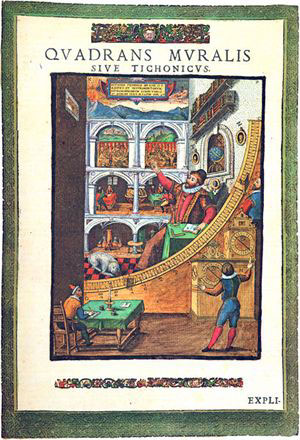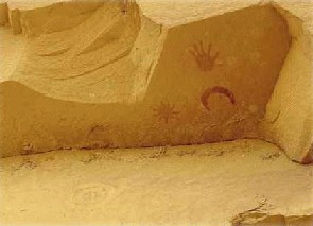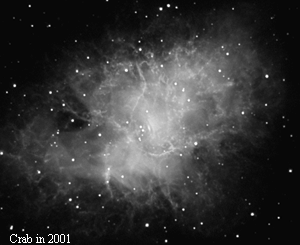Chapter 1. The Scientific Method
1.1 Introduction

Author: Grace L. Deming, University Of Maryland
Editor: Beth Hufnagel, Anne Arundel Community College

The goals of this module: At the end, you should be able to:
- Describe how the scientific method is used to acquire knowledge.
- Describe how scientists use prediction and observation to revise or strengthen theories.
In this module you will explore:
- The process of acquiring knowledge using the scientific method
- The role of prediction in science
- How advances in technology lead to new discoveries
Why you are doing it: Astronomers use the scientific method to acquire knowledge about the universe. As a student learning astronomy, you need a basic understanding of this systematic and logical approach used to investigate the nature of celestial objects. Astronomers use the scientific method to produce testable theories that over time gain (or lose!) credibility with supporting observations. One exciting aspect about science is that knowledge evolves over time as new discoveries are made and old ideas are challenged. Sometimes, revisions to current theories are necessary as new instruments, like the Hubble Space Telescope shown to the right, increase our ability to make observations and gather new information about the universe. Although our current understanding of astronomy will improve with new observations, you can be sure that the scientific method will still be used throughout your lifetime!
1.2 Background

No one knows when the first human first looked up into the sky and asked questions like, "What are those lights in the sky?" Early explanations for many observations of nature often involved stories about divine beings. Eventually, people began to look for more natural explanations. Early Greek philosophers realized that the universe is comprehensible. The approach that they used to gather new knowledge developed into what today is known as the scientific method.
Think back to your earlier school days. Most students are required to complete a science fair project at some point in their education. Usually, there is a packet given, which very carefully outlines the steps that must be included. Click here to see a sample science fair project.
Notice that the "Project" included a research report and bibliography. Read the student's hypothesis and glance through the research report.
Question 1.1
GAbuP1wFZCHfM48CproMfBpoWEzP9vf4+5jSO3m1BNEsh8zOAUwG4paaRmg9LIclzzS60VyKXVZ4vwn47yyBmLxIFgWEswFZbDfysyXdJbrQDwe/wyt3c4/Dx3fqAFA+u6RD0NicK6S2dnliSmJp9gEp87mr4KbLuQeT8vN5CzXt9uXD1enyEr9zBUbxf5dx0MwSXw==Incorrect. What if somebody else has already proven that your hypothesis is wrong? How could using references help you avoid this waste of your time?
In order to write a good hypothesis, you need to know what other scientists have discovered about the phenomenon that you are studying before you propose your hypothesis.
1.3 Steps in the Scientific Method
The basic components of the science fair project are similar but not identical to the procedure that scientists follow. A modern astronomer spends 8-10 years in college studying basic information about astronomy and physics. Then he or she usually begins research of his or her choice with a question or hypothesis. The entire cycle can be summarized like this:

After scrutinizing existing observations and/or experiments, a scientist:
1) Proposes a hypothesis

The hypothesis then must be tested for expected outcomes.
Using the hypothesis, the scientist:
2) Makes a prediction and tests it

The hypothesis must undergo rigorous testing to gain credibility. The testing procedure is an on-going process and other scientists may join in observing or experimentation. Many scientists:
3) Continue hypothesis testing

At any point if the hypothesis fails testing, it must be discarded or revised. A revised hypothesis undergoes the same process outlined in steps 2 and 3. As a hypothesis becomes supported with additional observations and/or experimentation, it gains credibility.
1.4 An Astronomical Example
In order to appreciate how scientific knowledge progresses, let's do a case study of an object that first appeared in the sky in the year 1054. Chinese astronomers reported a 'guest star' in the constellation of Taurus the bull on July 4, 1054. This star was reported at maximum brilliance to be 4 to 10 times brighter than the planet Venus, which is the brightest object in the sky next to the Sun and Moon. The Chinese recorded that the guest star was visible during the day for 23 days and remained visible to the naked eye at night for almost two years.
Throughout today's southwestern United States Native Americans painted or etched into rock at a number of locations what are considered to be representations of the Chinese 'guest star'. In the photograph below you are looking upward to a rock ledge near Anasazi ruins in Chaco Canyon, New Mexico. Look carefully to see the star to the left of the crescent representing the moon. So this 'guest star' would have been next to the crescent moon in Taurus and appeared in the eastern sky before sunrise on July 4, 1054. Astronomers understand the phases of the Moon so well that the lunar phase and Moon's position can be determined for past dates as well as predicted for future dates.

Question 1.2
gw1io/2DhVL4QCjZV9MFd+258OZ/D9JFwVk9UOEx+w9IfdO9FQBE1uqUrs+7vPUTnQp/OvfUmizQjrdGwWsbpsidPYNaM08vOMxe9C0d9DeegwykVZuDTCx19/1uIBUVi98V+A9akjowXOx+ihhOAtEpds4xYUtolZ53ll9CbNlrhblwiIAFQkv0lzP3V8xgbZkG3cQaYuHqgrgniRF3A5ys9+wUcwwdRCazyCI1bCYa1Rz9ddXMDeisPFWu9/+Bnz/SYnPZZpEoM1u9zJ2gM4Uf0Qbhon0269wCpUZexrPpkvm35CWpILD7KF+OIlj2o7kMZiGnULQ2IxbzzfDSn19CQ1cQlp8k1.5 Propose a Hypothesis

When astronomers began to use telescopes in the seventeenth century, our view of the Universe radically changed. New details became visible as objects that were too faint to be seen with the naked eye were revealed, such as the region shown to the right. The Hubble Space Telescope in orbit around the Earth has been collecting astronomical data since 1990. Placed above the blurring effects of the atmosphere, the telescope orbits more than 600 kilometers (370 miles) above the Earth's surface, moves at a speed of 28,200 kilometers per hour (17,500 miles per hour), and completes one orbit in 97 minutes. The picture to the right was made with the Hubble Space Telescope by combining into one picture 24 separate images taken between October 1999 and December 2000.
Question 1.3
JZB9Bh16tiPEuRBbHyzN8J6Des3/XugU1hnNzkyGJS8VncZVi4C0e3a5IPt17oMEcVXIsQc+b7FT7edM2QgORviOljqjPCOpvTz8ltVLWrThtNtJSgX7hpsXtsAscXBBUqaA7GAhuCw3JwUyNo6mTw4bNX9SOVWLLWKIVoNAxZ/q0qcEYcvyV0HMzgUAMky+WTRfUVr6GzrNgpaPxd2oFjhuhdPWzSkdytMsgPGeotqdMMsSAD5vSoSf4lQBYehv7kpNy2yM2Npt0aYWKAhiH6o76vMLnZmCyGVcKjP/x3ogiW4JCorrect.
Something occurred that has disrupted the gas seen in this image.
Long before the launch of the Hubble Space Telescope, astronomers used ground-based telescopes to scan the heavens. When Lord Rosse observed this object in 1844 through his telescope he thought that the gas looked like a crab and named it the Crab Nebula. A nebula is an enormous cloud of gas and dust. Once it was realized that the Crab Nebula coincided with the location of the brilliant 'guest star' that just appeared in 1054, a hypothesis was proposed that the nebula we see now through a telescope is all that remains of an exploded star.
Incorrect.
Something occurred that has disrupted the gas seen in this image.
Long before the launch of the Hubble Space Telescope, astronomers used ground-based telescopes to scan the heavens. When Lord Rosse observed this object in 1844 through his telescope he thought that the gas looked like a crab and named it the Crab Nebula. A nebula is an enormous cloud of gas and dust. Once it was realized that the Crab Nebula coincided with the location of the brilliant 'guest star' that just appeared in 1054, a hypothesis was proposed that the nebula we see now through a telescope is all that remains of an exploded star.
1.6 Make a Prediction and Test It
What prediction does this hypothesis make? Can the prediction be observed using available technology? If the hypothesis that a star tore itself apart is correct, then for a (relatively) tiny star to explode into an enormous nebula means that the nebula might still be moving away from the center.

Question 1.4
qfmLK3frCGE/q7Vo1+RalKs4eLiUnH8JSH1ZzK5cHKQMaqEAiIC6PAUvP5S0pVqnvHl+iD2fArLcrj14eMEnCD51Lbl+lesblF9LciTfj3QvmFC4g+ROGqcDTotqEacOanDoJDjDaJbsT6KD20slxjkOTfIPgSm13gqW2dCqwWp7zeu8/N9HNF6giaT6EkANqPsLqHU9byD1rvMXeyXd4vlq7mzJ3w5IaCs16SvXHBmGlrOB5S1gMLQbweenve8YjdA/DlifV2YazMqjDB02TfTIQCo=1.7 Continue Hypothesis Testing
Using the Mt. Wilson 100-inch telescope in 1942 to observe the Crab Nebula, Walter Baade compared his observations to those taken years earlier. He saw visible changes and estimated that the expansion started about 900 years ago. This is just about the time the 'guest star' was reported! Measurements taken reveal that the gas in the foreground of the nebula is approaching us at a velocity of approximately 1800 kilometers per second (km/s) or 1,800,000 meters per second (m/s). (To put this in perspective, your walking speed is about 1 m/s.) (This measurement is made using the Doppler effect, which you will study later.) As suggested by the visual appearance of the Crab Nebula, the hypothesis that an explosive event hurtled the gas outward at tremendous velocity is supported by these observations.
Astronomers have determined that the Crab Nebula lies at a distance of approximately 6500 light years within our own galaxy, which is about 100,000 light-years across. For the exploded star to be visible as reported in 1054, at that time it must have been emitting energy equivalent to 400 million suns. Today, astronomers record events of similar magnitude in other galaxies.
Theoretical models predict that some stars can indeed blow up in an event called a supernova. Below is a "before" and an "after" view of the Large Magellanic Cloud, a neighboring galaxy that is about 165,000 light year away. Despite being 25 times more distant than the 1054 supernova resulting in the Crab Nebula, the Large Magellanic Cloud supernova also was visible to the naked eye. It is estimated that at its brightest this event released 100 million times the energy of our Sun. Supernovae are routinely observed in other galaxies.
1.8 Revise the Hypothesis
In the 1930s, Walter Baade and Fred Zwicky predicted that after a star explodes, there would be a very compact object left at the location of the original star. Supporting observations for such objects called pulsars were first made in 1967. In 1968, one of these objects was found at the center of the Crab Nebula. The model explaining the observations made of pulsars involves a fast spinning compact object composed of neutrons - a neutron star.
The following movie that you are about to view shows this remarkable object in the Crab Nebula. It was made using images taken between November 2000 and April 2001 using the Hubble Space Telescope. You are peering into the central region of the Crab Nebula. The pulsar is energizing the gas surrounding it. The pulsar is the brighter object near the center of the movie. Watch the wisps of material moving outward. The movie is "looped" like rainstorms on a weather map, so you are seeing the same pattern over and over.
On the left you will see X-ray images taken by the Chandra Observatory and on the right you will see visible images taken by the Hubble Space Telescope. These instruments are located above our atmosphere.

Question 1.5
lSzfnznueBjD8frHLlJpICGG4RLBT6fXD7WIe8mY+Nd4Es1XD1ekSdC7q5Q0ClQkZm6SRjEpY5gaQPNn13sDo/QlCJbht2pUHns4vYTwkvXfAfmL14+5uAp4o98dGGMIwJK6UMRIF0YlH/QtZrX/FvGvixY9uKrezPebYVLzwo0NB8BXXTitUwGlf87oZHgG/UjodcEQhN+k+99cJR/c9mS2b15oDrdHeuYTKVmljRxgMj5uAniTytwmEQaRN5X31AWu0AH5hc7QDgY4hg3dq6tlQJiq/wBxqGUfDQKfJi+Um1bNRtC5UMzBLf3coPQlTjTsKrH4XtdVRD4juRkaBUapHEy1HJMM+6kXLY3E/0mdnDVOQRmjwJz8YKGpl63+LvPJeF/tjE8ZK74br4iVIoqFyfpMY1w5LgV8Gtk1PBDYNtMYdsqXcFZHnhklxZP8cLWBwuXtgQ9aS17rMlWgVCNiax4PyacUD9lnrnt6kBL1yDuXQPB9Swf0BInfIdiN1.9 Summary
In the example of the Crab Nebula, many people contributed over hundreds of years to reach our present understanding that this object resulted from the explosion of a star. Science progresses slowly in this manner. Review the steps of the scientific method below and think about how each pertains to the example of the Crab Nebula.
1) Proposes a hypothesis
From observations made centuries earlier, scientists of the 19th century proposed that the Crab Nebula resulted from the explosion of a star in 1054.

2) Makes a prediction and tests it
Prediction: An explosion would hurtle gas outward.
Observation: Gas is seen moving over decades.
Prediction: Event in 1054 hurtled gas outward.
Observation: Baade measured the velocity of the gas and estimated the event date.

3) Continue hypothesis testing
Prediction: After a supernova, a dense object is left.
Observation: Pulsar observations consistent with dense neutron star model.
Observations continue today to achieve a better, more complete understanding.
1.10 Quick Check Quiz
Indepth Activity:The Scientific Method
Question 1.6
boBl9P3dJK1wSPj4RV68U2igy6yFzTRAF90OEMgknlQUJTO0y+arRzZ0BXO4KlrQOOEgzfUOx56fs40LPUEkSYsOYtZO6xn+9bORNE3+uXILM++NPd7vzofc1pBLw3AL2lrL0B1GrIlZZcyWSf3ToEYFnS8QnEb3104vTTJlnadR+Q4j+RVa4rJ+WuVGqo6Ho/eamBHY4Hw9h0YlvvW0pqMVnKkp0WfKGt6TpEqarro/hhQEk7zQWLRT/75UcppGp5oHrXSsLmOhaMoVcSf7KoEz6T8O9dpv0oE3r9J0/E7GmnmkS4N/bCn1iyidvKgp6VCvzceRi3FUGD/oHBZublW9OKbYkdyPTQb6h9FTWBhHT65g2k4WxkTXFdqXBAcQCQrq2Y7wueXOwlp6eK1NqhmueSeWu9l/Jij9hABfxnQYmQbxfA1JmlnXMN2gfDlxHMp20tMXYg9/drUtryMGeTzrMFSVCKSlQ70HcTb199bY5bcpepmYDsRb4O0qqzomKz/iu5lsRSA=Question 1.7
nL+Agq4Ez+QO75htS6A02nxT1p9fmox9fsyvhVff1bDWdXsEIeIeSXjb3rkQ/r+7ts/xAjxt10FGT9/rPriqpdeP42IuvTQaQpSHAWrhXKCNc1izk7HmLIAmMl7HXfvnZ4tZiZtXJCKyLdM9MvwVkArdV8hGpw/bgR99ilTTkLypLCPp3mqD2fuanyrrZ+J/L/wQxDTMxdxc9drC758t0w87lPFvy3FMeDhXcMDgRhK7yCox02Q/Np+w8rfOtnWmDrIo24mbefmPA29y9XH51hOyUhcs+RyWbfGcoH47IJx24OvaWPF4BC2W1nRaP9dGRuQ0WAgrsyJTNzdS1xIc0AdTVB1/7YabXRl0/aO3Iq0XQHbzqu0KulVW9nQ6I8mzpo1iaZCQQ6QONQ9Hla+BAIY5BiVAX17k8XN6K78D+x6SB7T1Y6zZIcqVskb/41Pat4Mm/t8uQ/ur7Zx6l/XaQ82cB6Qn38q6Question 1.8
vJvOfdYB+Bf0xEgPvNHJNeo+Uh/FCg5Ro2Kqxykt2nhfJFPIr4Zxaws18VkzwzZpCCT3zlXI0Ix2+fSi3IGyhKIfa+D96bkjIcKcdKiO8V6ViW2VomqLBTaVz0xyAaeFiTtIKI3tQCAwYJdh8JyZbad8m0ocJTFo6L+Al3375+4hNNPolNW5lGXQaYPvc2pbrBYOQ6h9k+ZBsEAkIPZ2cBhVp3O2JAWh5ZhcwH1gY4eYPjTB0ROHdwIsZNtRxrYd2w36vvOefL6c5v6krEUJE8pMN8xTGygjMAjR2Uq2i5q4ExjHBR8WNEazvykX3nlEQuestion 1.9
3zId/mR8EWpw8ZKFWPBWAa09zNwtT0LeKY0h5u0Ij4bSDRfSvtJlUKpvUebyfVlxtA+Yg9QCLrSLvymH+5ilJPkk2RMX70lItigafotpVONEIXRswC4q9fQV8HTRSUx23u30uEchfqgrt1krzvKAjFs6OVZ701Aqc757dxUPduZA8+QvljDEUHQCnrvwHcitceNgyh/OlA/Ulxv2jOslBnyBN+wnp+V8KYK8xBINVhQ8LNQFKmVEftlD/xsVpQPHhE0UMcVafaglyehPP61fNY8ShD5YuL/HhA0fXA==1) proposes a hypothesis.
The hypothesis then must be tested for expected outcomes. Using the hypothesis, the scientist:
2) makes a prediction and tests it.
The hypothesis must undergo rigorous testing to gain credibility. The testing procedure is an on-going process and other scientists may join in observing or experimentation. Many scientists:
3) continue hypothesis testing.
At any point if the hypothesis fails testing, it must be discarded or revised.
1) proposes a hypothesis.
The hypothesis then must be tested for expected outcomes. Using the hypothesis, the scientist:
2) makes a prediction and tests it.
The hypothesis must undergo rigorous testing to gain credibility. The testing procedure is an on-going process and other scientists may join in observing or experimentation. Many scientists:
3) continue hypothesis testing.
At any point if the hypothesis fails testing, it must be discarded or revised.